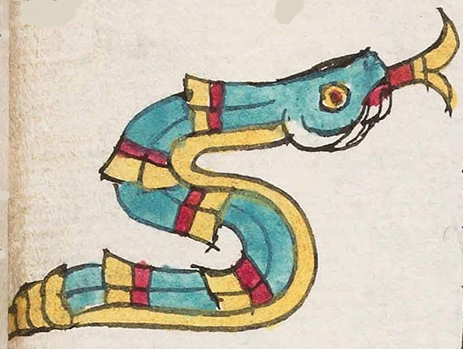coatl (Mdz55r)
This simplex glyph for a snake or serpent (coatl) also doubles for the place name Tziccoac features a turquoise-blue snake, somewhat coiled, in profile, and facing to the viewer's right. Its red and yellow bifurcated tongue protrudes. Its underbelly is yellow, and it has red and yellow markers periodically spaced along its back. Its tail has three rattlers.
Stephanie Wood
The elements of the term tziccoatl, presumably the root of the place name (with the locative -c not being visual), would appear to combine tzictli or tzictic (a word for a blue color, either turquoise or sky blue, judging by the translations in our dictionary and by the color of the snake in this glyph. Tzictli also means chewing gum, but that would not appear to be relevant here. The coatl part means snake or serpent.
The red and yellow markings might point to a specific snake that has such colors, perhaps a special type of garter snake or coral snake.
There is a Tziccoac in the Huasteca, also spelled Chicoaque, mentioned in Wikipedia as now "Mesa de Cacahuatengo in the municipality of Ixhuatlán de Madero."
The appearance of the serpent's tongue recalls the glyph for (tletl (fire or flame) (see below, right). Perhaps the snake's bite caused awe, much as fire did. Serpents did have an association with fire and the fire divinity, Xiuhtecuhtli, as explained by Esther Pasztory (paraphrased by Ian Mursell). The presence of rattles is also important, even if artists often omitted them, because rattlesnakes ware significant in Mesoamerican cultures, as the study of rattlesnakes by Ian Mursell of Mexicolore also elaborates. A wooden, turquoise-mosaic pectoral in the shape of a snake is held in the British Museum, whose curators have written: "The Mexica considered serpents to be powerful, multifaceted creatures that could bridge the spheres (the underworld, water and sky) owing to their physical and mythical characteristics." Besides being an animal that was common in the central highlands, the coatl is the name of the first day of a thirteen-day calendrical cycle.
The museum comparison, below, shows a remarkable similarity in the positioning of the serpent's body in an S-shape.
Stephanie Wood
by 1553 at the latest
Stephanie Wood
snakes, serpentes, serpientes, cohuatl, crótalos
Chicome Coatl. Carved stone image of a serpent that is part of a date glyph, 7-Coatl, or 7-Serpent. One of the circles of the notation appears to be broken off. Ethnologisches Museum, Berlin, Germany. Photograph by Robert Haskett, summer 2012.

coa(tl), snake or serpent, https://nahuatl.wired-humanities.org/content/coatl
tzictic, turquoise blue, https://nahuatl.wired-humanities.org/content/tzictic
serpent or snake
el serpiente
Stephanie Wood
Codex Mendoza, folio 55 recto, https://codicemendoza.inah.gob.mx/inicio.php?lang=english
The Bodleian Libraries, University of Oxford, hold the original manuscript, the MS. Arch. Selden. A. 1. This image is published here under the UK Creative Commons, “Attribution-NonCommercial-ShareAlike 3.0 License” (CC-BY-NC-SA 3.0).


